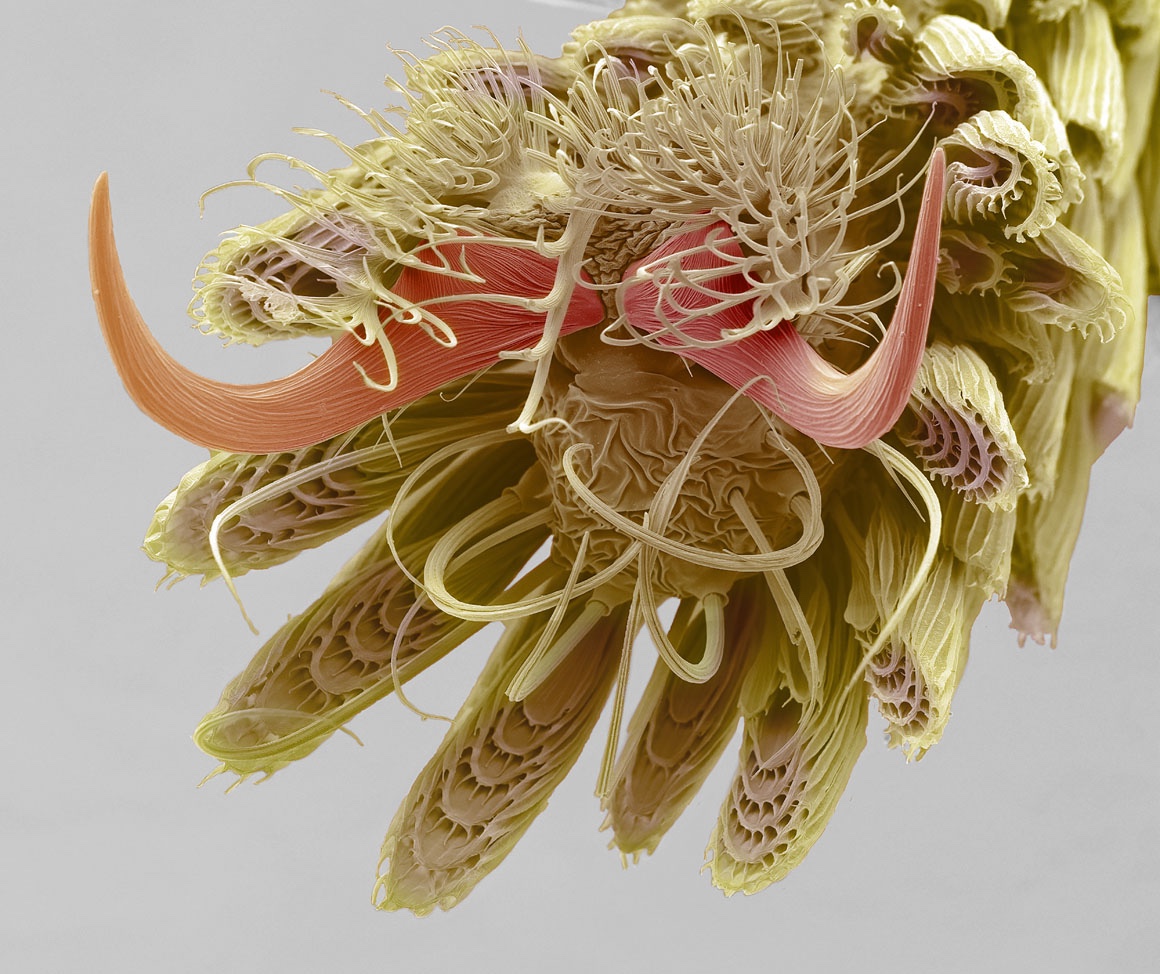What in the World Is This? Weird, Amazing Image Goes Viral

A worm with devil horns? Some sort of elaborate pasta creation? A vaguely nefarious tropical flower?
None of the above. This image, recently circulating on Reddit, is actually a mosquito's foot.
In a post on Reddit that garnered more than 32,000 upvotes, the photo doesn't come with much more backstory than that. But the image is actually from a scanning electron microscope made by photographer Steve Gschmeissner. It was shortlisted in the 2016 Royal Photography Society International Images for Science contest. It's been reposted around the web quite a bit since then, Gschmeissner told Live Science, possibly because of its unexpected complexity. [Magnificent Microphotography: 50 Tiny Wonders]
The image shows the end of a mosquito's leg, including a claw, scales and the pulvillus, a pad with adhesive hairs. According to Gschmeissner's photo description, these scales dot the entire bodies of mosquitos but are particularly dense near the foot, and may help protect the limb and enable the mosquito to land on water, where these insects lay their eggs.
"Insects are fantastic for that because they have all this sort of fine microscopic details," Gschmeissner said.
Related: Why is this viral image of unrecognizable objects so creepy?
Scientific artist
Gschmeissner has a degree in zoology and decades of experience in cancer research using scanning electron microscopy (SEM) at the Royal College of Surgeons in London. He retired early 10 years ago to turn to making SEM images full time, and says he's probably sold 25,000 images since then. His customers range from fine-art collectors and media companies to working scientists and album-cover designers.
Sign up for the Live Science daily newsletter now
Get the world’s most fascinating discoveries delivered straight to your inbox.
"There was even a fashion collection based on my images, so all sorts of weird things," Gschmeissner said.
Scanning electron microscopes blast a beam of electrons over the object to be imaged, which is coated in gold (a metal) so that the electrons scatter off the surface, returning information about its contours. Because they use electrons, SEMs have a very high resolution and can image even nanosize structures. (The mosquito foot was magnified 800 times.)
Miniature worlds
Gschmeissner has explored a huge variety of tiny worlds with this technique, many of which appear on his website, theworldcloseup.com. In his portfolio are spiders, millipedes and wasps, maggots and ants. He's photographed yeast cells, algae and the details of a marijuana leaf. Because of his background in cancer research, human microanatomy is a favorite subject, Gschmeissner said. He's used the SEM to image droplets of his own blood, revealing red blood cells and platelets in impressive detail.
He's also photographed humanity's invisible neighbors, from the bacteria found on dishcloths and mobile phones to the microbes that live in our mouths and kidneys — not to mention the mites you really didn't want to know call your eyelashes home. He's imaged ominous-looking cancer cells from the skin, the blood and the bones. And he's photographed pollen and parasites and household pests.
Gschmeissner rents time on a scanning electron microscope at the Central London School of Pharmacy to take these images. SEMs don't capture color, so he colorizes the images in Photoshop, sometimes aiming for a naturalistic look and sometimes for a more out-there artistic vibe.
"I'm lucky that I do something I love," Gschmeissner said. "I still enjoy and still get excitement out of it. When you first put something in a microscope, you are never really sure what you're going to see. You still see things you don't expect to see. When I get tired of it I'll stop, but I'm nearly 70 and I'm still doing it."
Original article on Live Science.

Stephanie Pappas is a contributing writer for Live Science, covering topics ranging from geoscience to archaeology to the human brain and behavior. She was previously a senior writer for Live Science but is now a freelancer based in Denver, Colorado, and regularly contributes to Scientific American and The Monitor, the monthly magazine of the American Psychological Association. Stephanie received a bachelor's degree in psychology from the University of South Carolina and a graduate certificate in science communication from the University of California, Santa Cruz.









